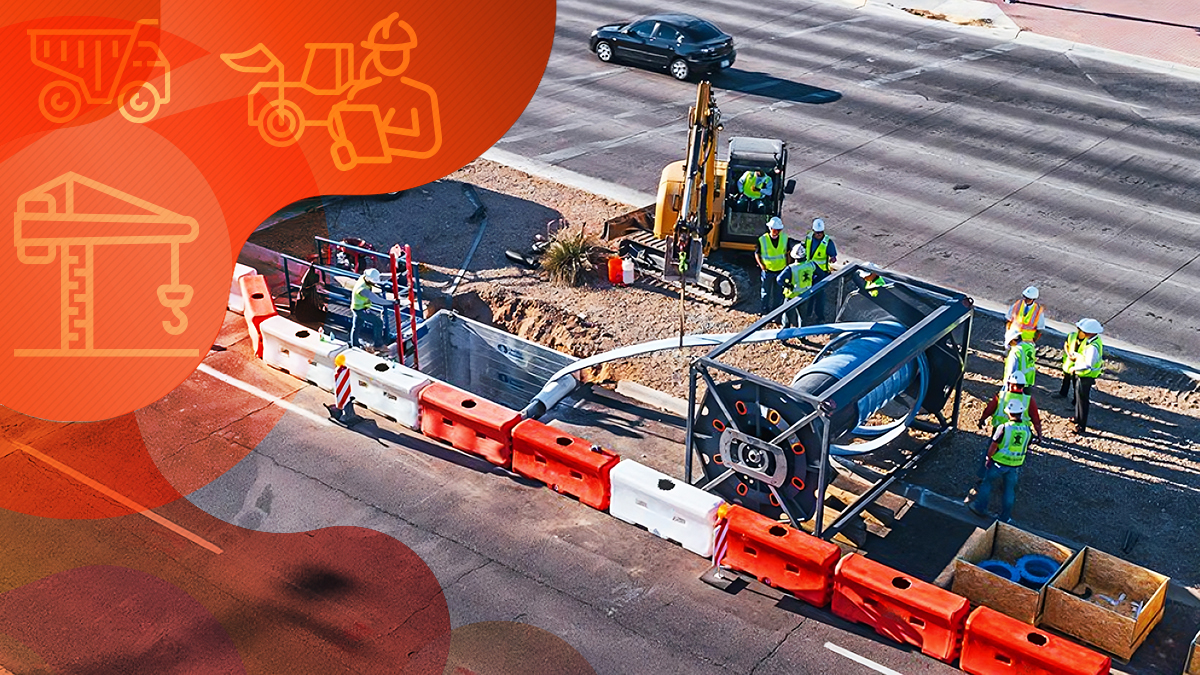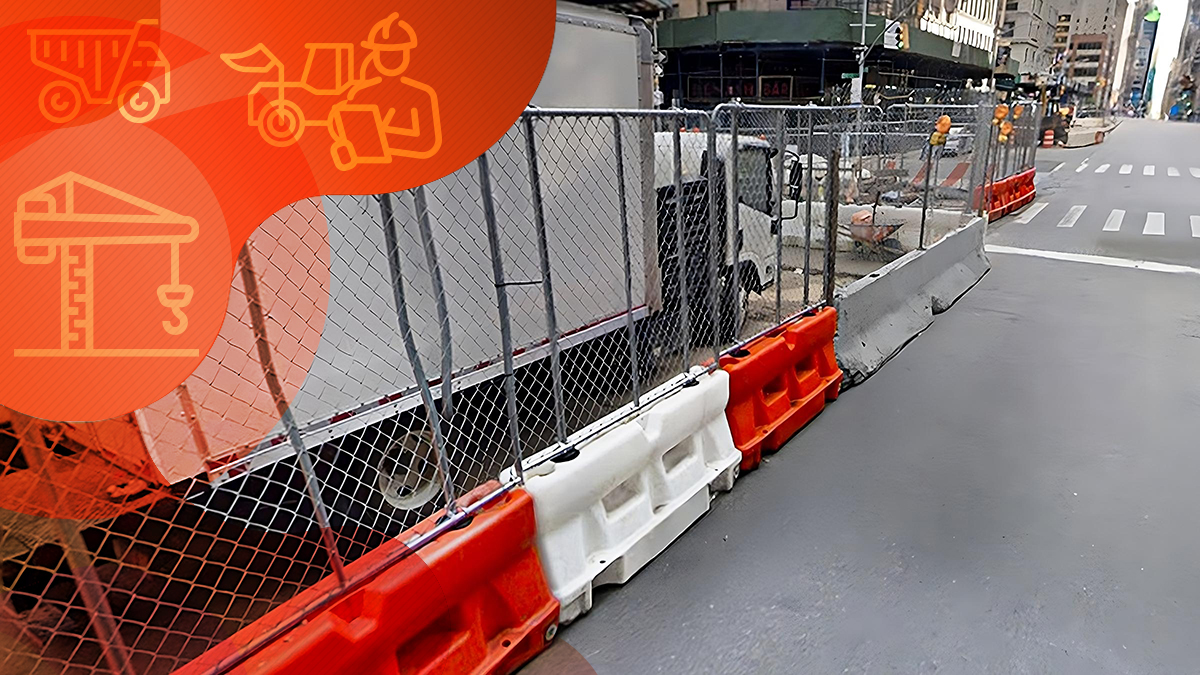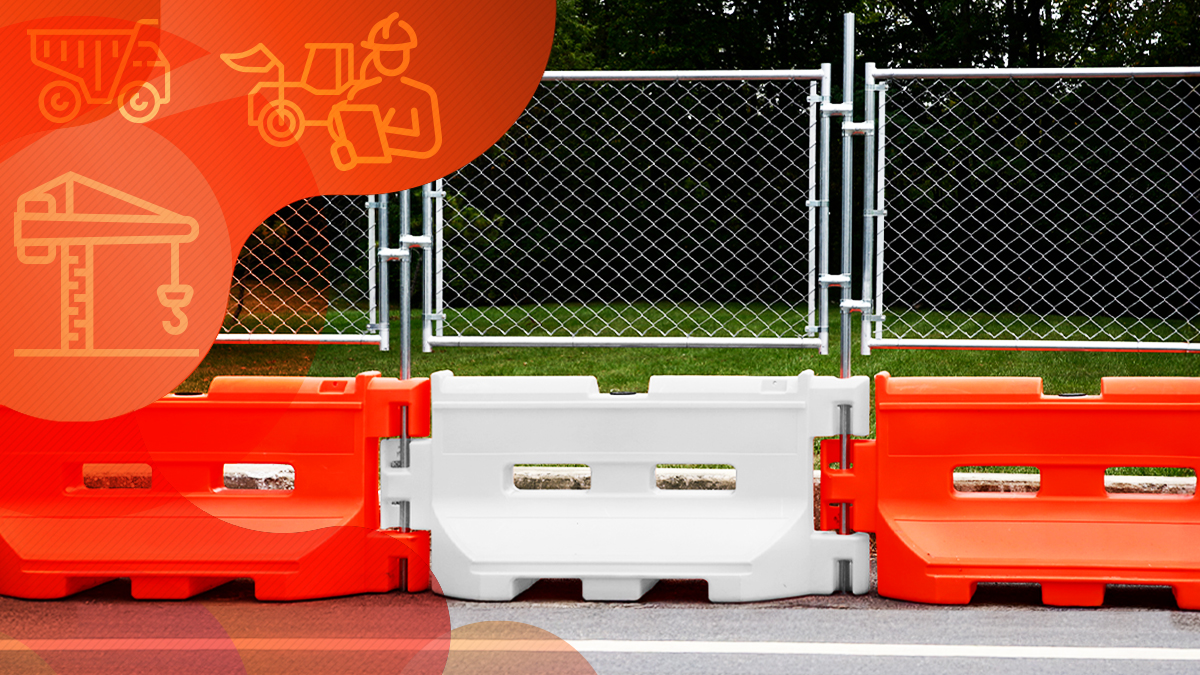A Guide to Barricading in Construction

Barricading in construction is a general term for a wide range of traffic control, pedestrian safety, and perimeter security equipment. This includes both permanent and temporary barricading, but most commonly temporary, as is the nature of construction sites.
Barricading is also done both outside and indoors. It’s utilized for large-scale projects as well as short-term renovations. And it can be as specific as a single piece of tape or as general as a mile-long roadside barrier.
The Purpose of Barricading in Construction
When it comes to setting up barricades at construction sites, these are the four primary goals:
- Increase safety
- Keep equipment secure
- Minimize liability
- Stay in compliance
But the ideal situation is avoiding the need for a barrier in general, which sounds impossible for a work zone. In terms of the whole site, that’s likely true. However, before you can begin to determine the barricades needed, this is step one:
Step One: Risk Assessment


In terms of both permanent and temporary barricading in construction, you’ll need to identify the potential hazards. But the next step isn’t necessarily choosing a barricade, demarcation, or sign, it’s deciding whether or not that hazard needs to exist. Can it be eradicated, replaced, or minimized to a safe degree? If so, then doing that is best practice.
However, if the hazard is not reasonably preventable, then barricading is required, as well as signage that clarifies the precautions that should be taken if applicable.
Read Too: Traffic Signs And Safety at Your Work Zone
How Long Should a Hazard Stay Barricaded?
In most cases, barricading in construction zones should stay in place around hazards indefinitely. So, if the hazard becomes non-existent, then the barricading is no longer needed. However, another risk assessment should be performed to ensure new hazards have not arisen in the wake of the previous.
If the hazard is permanent, then permanent barricading needs to be put in place.
Barricade Maintenance


On a highly related note to the above, temporary barricading needs to be updated on an ongoing basis. The frequency of the maintenance will depend on weather conditions, frequency of use, general wear and tear, and so on. The more durable the product, the less you’ll need to maintain it. On the flipside, the more economical, the more often you’ll have to do repairs.
To lessen the burden of barricade maintenance, consider factors making a long-term investment instead of a short-term investment (e.g., better quality products, buying instead of renting, etc.).
Another important consideration is ongoing productivity and potential interruptions. If you can’t legally operate when barricading requirements aren’t met due to maintenance concerns, that can be an extremely costly hiccup. On top of buying the highest quality products from a trusted brand, recognizing when a piece of equipment is close to breaking down can make a big difference. Best of all, it requires little more than regular inspections.
How Much Space Should Be Between Hazard and Barricades?
Barricading should keep folks as far away from the hazard as they need to be to stay safe. That’s certainly general, but each hazard has unique circumstances. For example, things like sparking and leaking can have a specific radius that you can barricade around.
Another great example is a construction site as a whole. The amount of space needed to protect traffic and pedestrians from the work is a much more clear-cut delineation. Keep that general concept in mind when determining the barricading needed for a more specific hazardous area.
It’s also important to expect the unexpected. If there’s a chance that a falling object might deflect off of something, for example, it’s crucial to take that into account.
Types of Barricades
While barricading in construction includes safety signage and information tags, most people likely imagine equipment like, well, barricades. While warnings are effective, nothing quite beats being physically unable to enter a hazardous area – at least without a bit of effort.
Here are some of the more common categories of barricading in construction when it comes to more demanding safety requirements:
Traffic Safety Cones and Drums


Delineating traffic is a huge part of many construction sites. You may need to direct vehicles within the site itself, you may need to direct vehicles outside of your site, or it’s a mix of the two. Either way, traffic cones and delineator drums feature high-visibility colors, reflective tape, and mounts to ensure they’re seen, understood, and followed.
The specific type of safety cones and drums you’ll need will depend on your site, and you’ll often find that having a wide variety on-hand can be particularly useful. At SONCO, we offer a robust selection of traffic delineators for that very reason.
Read Too: 10 Tips for Your Road Construction Site
Roadside Barriers


You may be required to have concrete Jersey barriers protecting your site, particularly if your work zone is on the highway. However, you may be able to use water-filled barriers instead, a more affordable, highly visible alternative to the concrete alternatives. These high-impact barriers can be filled and emptied on-site for easier transport, and they’re adaptable to a wide range of applications.
Further, a popular addition to the water-filled barriers is the temporary fence toppers, which add additional security on top of the safety measures. They make great places to put safety signage as well as a fence screen depending on the needs.
Bike Rack Barricades


The barricade’s barricade. This is what folks picture when they hear the term, because it’s what they stand behind at parades, festivals, and beyond. The SONCO heavy-duty steel barricades are an extremely common choice for both the construction and event industries, utilized by giant development companies and renowned law enforcement agencies.
Barricades feature both exceptional durability and transportability. That makes them a versatile addition to worker management within construction sites, as well as visitor safety. The hot-dipped galvanized options are also weather- and corrosion-resistant, making them ideal for indoor and outdoor use alike. For extra protection, consider upgrading to powder-coated steel.
Temporary Fence Panels


Temporary fence panels are an affordable but long-term perimeter security measure that protects construction sites from unauthorized entry. Combined with a fence screen, and they become an effective means of privacy as well.
Commonly, temp fence panels are connected via zip ties or similar products to create an uninterrupted barrier line (versus interlocking steel barricades with built-in connector hooks and loops). They’re also available in a variety of different feet, including the T feet, bridge feet, and wheeling feet.
At SONCO, you can also replace your cement blocks and sandbags with temp fence blocks and weights that last longer, look better, and reduce tripping. Click here to see the products.
ANSI and OSHA Safety
For both safety equipment as well as signs, labels, and tags, the American National Standards Institute (ANSI) and the Occupational Safety and Health Administration (OSHA) are the two organizations you’ll hear brought up most often. However, there’s a very important distinction:
The Difference Between ANSI and OSHA
The governmental oversight that determines the compliance of barricading in construction is OSHA, which means that not being OSHA compliant can get your site shut down, licenses revoked, and all sorts of nasty repercussions.
ANSI, on the other hand, is an organization that makes best-practice suggestions for all sorts of projects, including construction work. What’s great about ANSI for contractors is that you can use their guidance to add additional safety measures that aren’t necessarily required by OSHA.
But, at the minimum, you need to have OSHA safety signage that follows their strict guidelines.
Also Check Out: Meeting OSHA Requirements For Construction Signs
Types of OSHA Safety Signage


While there are a handful of different types of OSHA Safety Signage, there are some general rules that apply to all of them; namely, that they be bilingual and universally understood. Further, an OSHA sign is categorized under the umbrella of barricading in construction, because a sign is often enough to deliver a specific safety precaution.
Beyond the general, here is a useful list of the different types of OSHA safety signage:
- OSHA Header Signs
- Construction Safety and Roadside Signs
- Chemical and Hazardous Materials (HazMat) Signs
- Machine Safety and Warning Signs
- No Access Signs
- Arc Flash Electric Hazard and Warning Signs
- Confined Space Signs
- Lockout Signs
You also might be in a position to order custom OSHA safety signage. This could include some more nuanced precautions specific to your site. You also might want your company colors present rather than the more standard color schemes.
Just make sure you order from a reputable crowd control and perimeter security company with experience in construction, as specific colors are required for certain OSHA requirements.
The Most Common OSHA Violations
The easiest way to avoid a violation? Knowing what the most common violations are and avoiding them at all costs. Here are the OSHA Standards (both the number and the title) that are broken most often at construction sites across the country:
- 1926.501: Duty to Have Fall Protection
- 1910.200: Hazard Communication
- 1926.451: Scaffolds
- 1910.200: Respiratory Protection
- 1910.147: The Control of Hazardous Energy (Lockout/Tagout)
- 1926.1053: Ladders
- 1910.178: Powered Industrial Trucks
- 1926.503: Training Requirements
- 1910.212: General Requirements For All Machines
- 1926.95: Criteria For Personal Protective Equipment.
Trend now

Reducing Impact Damage with Water-Filled Plastic Jersey Barriers
Understanding the effects of barrier materials on vehicles and their occupants can help improve road safety.

Choosing Between Concrete or Plastic Jersey Barriers
Not all barriers are built the same. Here’s what to know before choosing between plastic and concrete.

Advantages of Water Barriers with Fence Toppers
Learn how a fence topper transforms water barriers into a more secure, private, and effective work site solution.


